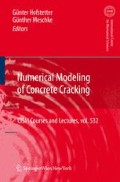Abstract
Models for the numerical simulation of concrete cracking are traditionally based either on the smeared crack approach or the discrete crack approach.
Access this chapter
Tax calculation will be finalised at checkout
Purchases are for personal use only
Preview
Unable to display preview. Download preview PDF.
Bibliography
H. Kupfer, H.K. Hilsdorf and H. Rüsch, Behavior of Concrete under Biaxial Stresses, ACI Journal, Vol. 66, pages 656–666, 1969.
J. Walraven, H. Reinhardt, Theory and experiments on the mechanical behavior of cracks in plain and reinforced concrete subjected to shear loading, Heron 26:5–68, 1981.
J.G.M. van Mier, Complete Stress-Strain Behavior and Damaging Status of Concrete under Multiaxial Conditions, Proceedings of the International Conference on Concrete under Multiaxial Conditions, RILEM — CEB — CNRS, Presses de’l Université Paul Sabatier, Toulouse, 1984, pages 75–85, 1984.
RILEM TC50-FMC: Determination of the fracture energy of mortar and concrete by means of three-point bend tests on notched beams, RILEM Materials and Structures, Vol. 107, pages 407–413, 1985.
J. Oliver, A consistent characteristic length for smeared cracking models, International Journal for Numerical Methods in Engineering 28, 431–474 1989.
M.A. Crisfield and J. Wills, Analysis of R/C panels using different concrete models, Journal of Engineering Mechanics, Vol. 115, pages 578–597, 1989.
J. Lubliner, Plasticity Theory, Macmillan, New York, 1990.
CEB-FIP Model Code 1990. Bulletin d’information, Comité Euro-International du Béton (CEB), Lausanne, 1991.
Hassanzadeh M. Behavior of fracture process zones in concrete influenced by simultaneously applied normal and shear displacements. Dissertation, Lund Institute; 1992.
M.B. Nooru-Mohamed. Mixed-mode fracture of concrete: An experimental approach. Ph.D. Thesis, Delft University of Technology, Delft, 1992.
O.C. Zienkiewicz, J.Z. Zhu, The superconvergent patch recovery (SPR) and adaptive finite element refinement. Computer Methods in Applied Mechanics and Engineering, 101, 207–224, 1992.
J. Simo, J. Oliver, F. Armero, An analysis of strong discontinuities induced by strain-softening in rate-independent inelastic solids, Computational Mechanics, 12, 277–296, 1993.
G. Hofstetter and H. Mang, Computational Mechanics of Reinforced Concrete Structures, Vieweg Verlag, 1995.
J. Oliver, Modelling strong discontinuities in solid mechanics via strain softening constitutive equations. Part 1: Fundamentals, International Journal for Numerical Methods in Engineering, 39:3575–3600, 1996.
P.H. Feenstra and R. de Borst, A composite plasticity model for concrete, International Journal of Solids and Structures, Vol. 33, pages 707–730, 1996.
J.G.M. van Mier. Fracture Processes of Concrete. Series: New Directions in Civil Engineering, Vol. 12, CRC Press, 1997.
R. Meiswinkel and H. Rahm, Modelling tension stiffening in RC structures regarding non-linear design analyses, European Conference on Computational Mechanics (ECCM 1999), CD-ROM, 20 pages, 1999.
R. I. Borja, A finite element model for strain localization analysis of strongly discontinuous fields based on standard Galerkin approximation, Computer Methods in Applied Mechanics and Engineering, 190, 1529–1549, 2000.
A. Vigl, Honeycomb segmental tunnel linings — simple, economical, successful, Felsbau, Vol. 18, pages 24–31, 2000.
B. Trunk, Einfluss der Bauteilgröβe auf die Bruchenergie von Beton, AEDIFICATIO Publishers, D-79104 Freiburg, 2000.
[Jirasek(2001)] Jirásek M, Zimmermann T, Embedded crack model: Part II: Combination with smeared cracks, International Journal for Numerical Methods in Engineering, 50(6):1291–1305, 2001.
B. Winkler, Traglastuntersuchungen von unbewehrten und bewehrten Betonstrukturen auf der Grundlage eines objektiven Werkstoffgesetzes für Beton, Dissertation, University of Innsbruck, Austria, 2001.
B. Winkler, G. Hofstetter and G. Niederwanger, Experimental verification of a constitutive model for concrete cracking, Proceedings of the Institution of Mechanical Engineers, Part L, Materials: Design and Applications, Vol. 215, pages 75–86, 2001.
M. Jirásek, and T. Belytschko, Computational resolution of strong discontinuities, Proc.World Congress on Computational Mechanics, WCCM V, Eds.: Mang, H.A. and Rammerstorfer, F.G. and Eberhardsteiner, J., Vienna University of Technology, Austria, http://wccm.tuwien.ac.at, 2002.
J. Oliver, A. E. Huespe, E. Samaniego, E. W. V. Chaves, On strategies for tracking strong discontinuities in computational failure mechanics, in: H. Mang, F. Rammerstorfer, J. Eberhardsteiner (Eds.), Proc.World Congress on Computational Mechanics, WCCM V, Vienna University of Technology, Austria, 2002, http://wccm.tuwien.ac.at.
E. Samaniego, Contributions to the Continuum Modelling of Strong Discontinuities in Two-dimensional Solids, Ph.D. thesis, UPC Barcelona, 2003.
J. Mosler, G. Meschke, 3D modeling of strong discontinuities in elastoplastic solids: Fixed and rotating localization formulations, International Journal for Numerical Methods in Engineering 57, 1553–1576, 2003.
S. Rolshoven, M. Jirásek. Numerical aspects of nonlocal plasticity with strain softening. In N. Bićanić, R. de Borst, H. Mang, and G. Meschke, editors, Computational Modelling of Concrete Structures (EURO-C 2003), St. Johann im Pongau, Austria, Lisse, The Netherlands, Swets & Zeitlinger B.V., 305–314, 2003.
B. Winkler, G. Hofstetter and H. Lehar, Application of a constitutive model for concrete to the analysis of a precast segmental tunnel lining, International Journal for Numerical and Analytical Methods in Geomechanics, Vol. 28, pages 797–819, 2004.
J. Oliver and A.E. Huespe and P.J. Sanchez, A comparative study on finite elements for capturing strong discontinuities: E-FEM vs. X-FEM, Computer Methods in Applied Mechanics and Engineering, 195, 4732–4752, 2006.
C. Feist, G. Hofstetter, An Embedded Strong Discontinuity Model for Cracking of Plain Concrete, Computer Methods in Applied Mechanics and Engineering, 195, 7115–7138, 2006.
ABAQUS Inc., ABAQUS/Standard Users Manual, Version 6.6, Providence, RI, USA, 2006.
C. Feist, G. Hofstetter, Three-dimensional fracture simulations based on the SDA, International Journal for Numerical and Analytical Methods in Geomechanics, 31, 189–212, 2007.
Y. Theiner, G. Hofstetter, Numerical Prediction of Crack Propagation and Crack Widths in Concrete Structures, Engineering Structures, 31, 1832–1840, 2009.
Author information
Authors and Affiliations
Editor information
Editors and Affiliations
Rights and permissions
Copyright information
© 2011 CISM, Udine
About this chapter
Cite this chapter
Hofstetter, G., Feist, C., Lehar, H., Theiner, Y., Valentini, B., Winkler, B. (2011). Plasticity based crack models and applications. In: Hofstetter, G., Meschke, G. (eds) Numerical Modeling of Concrete Cracking. CISM International Centre for Mechanical Sciences, vol 532. Springer, Vienna. https://doi.org/10.1007/978-3-7091-0897-0_4
Download citation
DOI: https://doi.org/10.1007/978-3-7091-0897-0_4
Publisher Name: Springer, Vienna
Print ISBN: 978-3-7091-0896-3
Online ISBN: 978-3-7091-0897-0
eBook Packages: EngineeringEngineering (R0)

